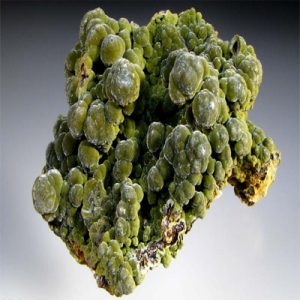Mottramite
Mottramite is a rare lead, copper, vanadinate mineral that is rarely available as a faceted gem. It is usually opaque black and found as minute crystals to 3 mm or druzy crusts. Transparent crystals large enough for faceting are very rare. Mottramite is an end member of the Mottramite-Descloizite series. Mottramite is the copper rich end member while Descloizite is the zinc rich member. Both minerals usually contain significant percentages of both elements and are rarely pure. One of the few lacalities for gem quality crystals is the Bookcliffs, Mesa County, Colorado, USA.
Non gemmy specimens are available from many localities: from Mottram St. Andrew, Cheshire, England. In the USA, at the Mammoth-St. Anthony mine, Tiger, Pinal County, from Bisbee, Cochise County, at the Total Wreck mine, Pinal County, in the Apache mine, near Globe, and from the 79 mine, near Hayden, Gila County, Arizona; at the Mayflower mine, Socorro Peak district, Socorro County, New Mexico; from the Whale mine, Goodsprings district, Clark County, Nevada. At Mina Grande, Arqueros, Coquimbo, Chile. Abundant at Tsumeb and elsewhere in the Otavi district, Namibia. At Kabwe (Broken Hill), Zambia.
| Category: | Vanadate minerals |
| Chemical Formula: | PbCu(VO4)(OH) |
| Lead Copper Vanadinate Hydroxide | |
| Molecular Weight: | 402.69 gm |
| Composition: | Vanadium | 12.65 % | V | 22.58 % | V2O5 |
| Copper | 15.78 % | Cu | 19.75 % | CuO | |
| Hydrogen | 0.25 % | H | 2.24 % | H2O | |
| Lead | 51.45 % | Pb | 55.43 % | PbO | |
| Oxygen | 19.87 % | O | |||
| 100.00 % | 100.00 % | = TOTAL OXIDE |
| Crystallography: | Orthorhombic – Dipyramidal |
| Crystal Habit: | As crystals, equant or dipyramidal {111}, prismatic [001] or [100], with {101}, {201}, many others, to 3 mm, in drusy crusts, botryoidal, usually granular to compact, massive. |
| Twinning: | None |
| Cleavage: | None observed |
| Fracture: | Small Conchoidal to Irregular/Uneven |
| Tenacity: | Brittle |
| Moh’s Hardness: | 3.0 – 3.5, somewhat harder on crystal surfaces |
| Density: | ~ 5.90 (g/cm3) |
| Luminescence: | None |
| Radioactivity: | Not Radioactive |
| Other: | Readily soluble in acids. |
| Color: | Grass-Green, Olive-Green, Yellow-Green, Siskin-Green, Blackish Brown, nearly Black. Crystals often exhibit zonal growth with varying colours. |
| Transparency: | Transparent to nearly Opaque |
| Luster: | Greasy |
| Refractive Index: | 2.170 – 2.320 Biaxial ( – ) |
| Birefringence: | 0.120 – 0.150 |
| Dispersion: | Strong; r > v, rarely r < v |
| Pleochroism: | Visible. Weak to Strong; X = Y = canary-yellow to greenish yellow; Z = brownish yellow. Orientation: X = c; Y = b; Z = a |
Mottramite is a rare lead, copper, vanadinate mineral that is rarely available as a faceted gem. It is usually opaque black and found as minute crystals to 3 mm or druzy crusts. Transparent crystals large enough for faceting are very rare. Mottramite is an end member of the Mottramite-Descloizite series. Mottramite is the copper rich end member while Descloizite is the zinc rich member. Both minerals usually contain significant percentages of both elements and are rarely pure. One of the few lacalities for gem quality crystals is the Bookcliffs, Mesa County, Colorado, USA.
Non gemmy specimens are available from many localities: from Mottram St. Andrew, Cheshire, England. In the USA, at the Mammoth-St. Anthony mine, Tiger, Pinal County, from Bisbee, Cochise County, at the Total Wreck mine, Pinal County, in the Apache mine, near Globe, and from the 79 mine, near Hayden, Gila County, Arizona; at the Mayflower mine, Socorro Peak district, Socorro County, New Mexico; from the Whale mine, Goodsprings district, Clark County, Nevada. At Mina Grande, Arqueros, Coquimbo, Chile. Abundant at Tsumeb and elsewhere in the Otavi district, Namibia. At Kabwe (Broken Hill), Zambia.
| Chemical Formula: | PbCu(VO4)(OH) |
| Lead Copper Vanadinate Hydroxide | |
| Molecular Weight: | 402.69 gm |
| Composition: | Vanadium | 12.65 % | V | 22.58 % | V2O5 |
| Copper | 15.78 % | Cu | 19.75 % | CuO | |
| Hydrogen | 0.25 % | H | 2.24 % | H2O | |
| Lead | 51.45 % | Pb | 55.43 % | PbO | |
| Oxygen | 19.87 % | O | |||
| 100.00 % | 100.00 % | = TOTAL OXIDE |
| Crystallography: | Orthorhombic – Dipyramidal |
| Crystal Habit: | As crystals, equant or dipyramidal {111}, prismatic [001] or [100], with {101}, {201}, many others, to 3 mm, in drusy crusts, botryoidal, usually granular to compact, massive. |
| Twinning: | None |
| Cleavage: | None observed |
| Fracture: | Small Conchoidal to Irregular/Uneven |
| Tenacity: | Brittle |
| Moh’s Hardness: | 3.0 – 3.5, somewhat harder on crystal surfaces |
| Density: | ~ 5.90 (g/cm3) |
| Luminescence: | None |
| Radioactivity: | Not Radioactive |
| Other: | Readily soluble in acids. |
| Color: | Grass-Green, Olive-Green, Yellow-Green, Siskin-Green, Blackish Brown, nearly Black. Crystals often exhibit zonal growth with varying colours. |
| Transparency: | Transparent to nearly Opaque |
| Luster: | Greasy |
| Refractive Index: | 2.170 – 2.320 Biaxial ( – ) |
| Birefringence: | 0.120 – 0.150 |
| Dispersion: | Strong; r > v, rarely r < v |
| Pleochroism: | Visible. Weak to Strong; X = Y = canary-yellow to greenish yellow; Z = brownish yellow. Orientation: X = c; Y = b; Z = a |


